is your dog overweight? At least he would not be alone in this, because almost every second dog is unfortunately overweight nowadays. Tendency increasing: more and more dogs suffer from overweight. There are many different reasons for this. The most common, however, is the lack of balance between exercise and feed quantity. The most common causes of obesity I reveal here: CAUSES OF OVERWEIGHT – SO YOUR DOG GETS FAT!
You are unsure if your dog is too fat?
Back or forth, obesity is a touchy subject. Many dog owners find it very difficult to assess whether their dog is too fat. Do you feel the same way? The neighbor says yes, the vet says no. And you’re just at a loss. Therefore, in this article I have compiled the most important characteristics for underweight, normal weight and overweight.
What is the right body weight?
You should rather not orientate yourself on the weight itself. It is rarely a useful yardstick. For some breeds and especially for mixed breeds no reliable data for normal weight exist. And somehow every dog is to be considered individually.
Basically, they say that in a normal weight dog, the ribs should be easy to feel with little pressure applied. But already here there is the first exception: a greyhound should have a so-called “dry” body. This means that he should look rather “lean”. In a bulldog, on the other hand, the ribs should not be visible because of the thick skin.
What about a BMI?
The also with humans already again disputed BMI for the determination of the nourishing condition does not really exist with the quadruped. But various physical traits will help you know how your dog’s weight is doing.
This classification will help you to see if your dog is overweight
Malnourished: Bony prominences such as ribs, spine and pelvic bones are visible and just under the skin. No discernible body fat, reduced musculature, clearly rising chest-abdominal line, very distinct waistline.
very slim/slim:The ribs are easily palpable with the flat of the hand, slightly visible if necessary. Clearly visible waist and hip bump, distinctly rising chest-abdominal line, minimal subcutaneous fat.
IDEAL: The ribs are easily palpable with little fat coverage, the waist is identifiable. Retraction of the posterior abdominal region visible from the side.
overweight: ribs under fat layer can be felt only when pressure is applied, no clearly visible waistline. Fat accumulation in the loin area and at the base of the tail, beginning circumferential increase in the abdomen. No rise between chest and abdomen.
Obese/severely obese: ribs not palpable, no discernible waistline, fat pads in hip area. Fat deposits on the neck and significant increase in circumference in the abdominal area up to a pot belly.
A dog should get so much energy through food at existing normal weight that he neither gains nor loses weight.
My recommendation:
Don’t rely purely on your sense of sight. Weigh your dog at regular intervals, preferably on the same scale. If you continuously keep an eye on your dog’s weight, you will save him from possible diseases and consequences of overweight and also from exhausting diets.
All the love, your Tina
Dog too fat Dog too fat Dog too fat Dog too fat Dog too fat Dog too fat
Dieser Beitrag ist auch verfügbar auf:
Français (French)
Deutsch (German)
Español (Spanish)
















